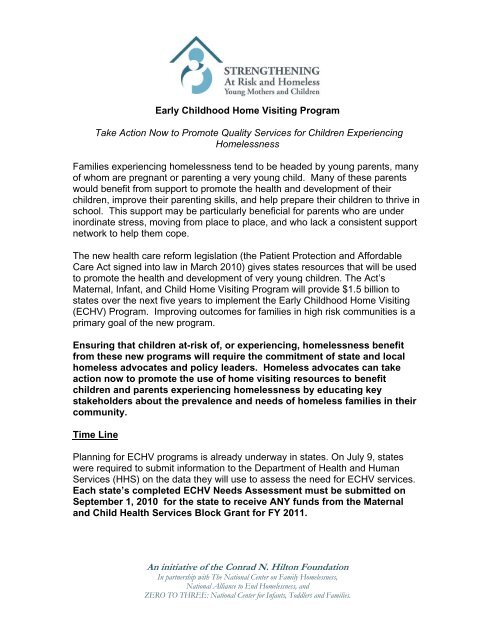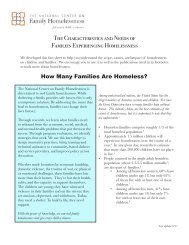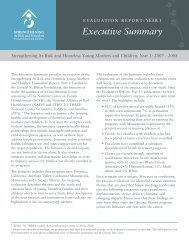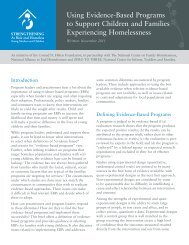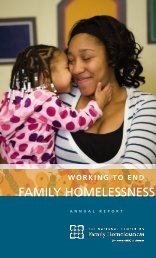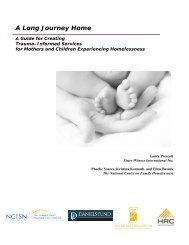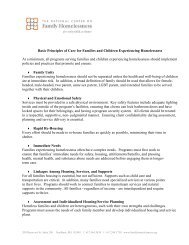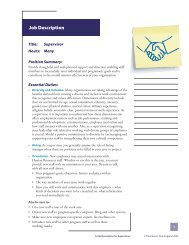Early Childhood Home Visiting Program - National Center on Family ...
Early Childhood Home Visiting Program - National Center on Family ...
Early Childhood Home Visiting Program - National Center on Family ...
Create successful ePaper yourself
Turn your PDF publications into a flip-book with our unique Google optimized e-Paper software.
<str<strong>on</strong>g>Early</str<strong>on</strong>g> <str<strong>on</strong>g>Childhood</str<strong>on</strong>g> <str<strong>on</strong>g>Home</str<strong>on</strong>g> <str<strong>on</strong>g>Visiting</str<strong>on</strong>g> <str<strong>on</strong>g>Program</str<strong>on</strong>g><br />
Take Acti<strong>on</strong> Now to Promote Quality Services for Children Experiencing<br />
<str<strong>on</strong>g>Home</str<strong>on</strong>g>lessness<br />
Families experiencing homelessness tend to be headed by young parents, many<br />
of whom are pregnant or parenting a very young child. Many of these parents<br />
would benefit from support to promote the health and development of their<br />
children, improve their parenting skills, and help prepare their children to thrive in<br />
school. This support may be particularly beneficial for parents who are under<br />
inordinate stress, moving from place to place, and who lack a c<strong>on</strong>sistent support<br />
network to help them cope.<br />
The new health care reform legislati<strong>on</strong> (the Patient Protecti<strong>on</strong> and Affordable<br />
Care Act signed into law in March 2010) gives states resources that will be used<br />
to promote the health and development of very young children. The Act’s<br />
Maternal, Infant, and Child <str<strong>on</strong>g>Home</str<strong>on</strong>g> <str<strong>on</strong>g>Visiting</str<strong>on</strong>g> <str<strong>on</strong>g>Program</str<strong>on</strong>g> will provide $1.5 billi<strong>on</strong> to<br />
states over the next five years to implement the <str<strong>on</strong>g>Early</str<strong>on</strong>g> <str<strong>on</strong>g>Childhood</str<strong>on</strong>g> <str<strong>on</strong>g>Home</str<strong>on</strong>g> <str<strong>on</strong>g>Visiting</str<strong>on</strong>g><br />
(ECHV) <str<strong>on</strong>g>Program</str<strong>on</strong>g>. Improving outcomes for families in high risk communities is a<br />
primary goal of the new program.<br />
Ensuring that children at-risk of, or experiencing, homelessness benefit<br />
from these new programs will require the commitment of state and local<br />
homeless advocates and policy leaders. <str<strong>on</strong>g>Home</str<strong>on</strong>g>less advocates can take<br />
acti<strong>on</strong> now to promote the use of home visiting resources to benefit<br />
children and parents experiencing homelessness by educating key<br />
stakeholders about the prevalence and needs of homeless families in their<br />
community.<br />
Time Line<br />
Planning for ECHV programs is already underway in states. On July 9, states<br />
were required to submit informati<strong>on</strong> to the Department of Health and Human<br />
Services (HHS) <strong>on</strong> the data they will use to assess the need for ECHV services.<br />
Each state’s completed ECHV Needs Assessment must be submitted <strong>on</strong><br />
September 1, 2010 for the state to receive ANY funds from the Maternal<br />
and Child Health Services Block Grant for FY 2011.<br />
An initiative of the C<strong>on</strong>rad N. Hilt<strong>on</strong> Foundati<strong>on</strong><br />
In partnership with The <str<strong>on</strong>g>Nati<strong>on</strong>al</str<strong>on</strong>g> <str<strong>on</strong>g>Center</str<strong>on</strong>g> <strong>on</strong> <strong>Family</strong> <str<strong>on</strong>g>Home</str<strong>on</strong>g>lessness,<br />
<str<strong>on</strong>g>Nati<strong>on</strong>al</str<strong>on</strong>g> Alliance to End <str<strong>on</strong>g>Home</str<strong>on</strong>g>lessness, and<br />
ZERO TO THREE: <str<strong>on</strong>g>Nati<strong>on</strong>al</str<strong>on</strong>g> <str<strong>on</strong>g>Center</str<strong>on</strong>g> for Infants, Toddlers and Families.
The state’s ECHV Needs Assessment will take into account, and be coordinated<br />
with, other federally required needs assessments for children’s programs<br />
including the Maternal and Child Health Services Block Grant <str<strong>on</strong>g>Program</str<strong>on</strong>g>, Head<br />
Start, and the Child Abuse Preventi<strong>on</strong> and Treatment Act. The needs<br />
assessment will:<br />
• Identify communities with high c<strong>on</strong>centrati<strong>on</strong>s of:<br />
o premature births;<br />
o low birth-weight infants;<br />
o infant mortality (including deaths related to abuse);<br />
o indicators of at-risk prenatal, newborn, or child health;<br />
o poverty;<br />
o crime;<br />
o domestic violence;<br />
o high rates of high school drop-outs;<br />
o unemployment; or<br />
o child maltreatment.<br />
• Identify the quality and quantity of existing programs for ECHV<br />
within the state, including the number and types of individuals and<br />
families receiving services, gaps in care, and extent to which<br />
programs are meeting the needs of eligible families.<br />
• Discuss the state’s capacity to provide substance abuse treatment<br />
and counseling to individuals and families in need of these<br />
services.<br />
Following the submissi<strong>on</strong> of the ECHV needs assessment, states will be required<br />
to submit an updated plan. The plan will describe how the state will use program<br />
resources to address the service gaps identified in the needs assessment. States<br />
will be able to draw down the remaining FY 2010 and FY 2011 ECHV program<br />
funds when their updated state plan is approved by HHS. The development of<br />
the state plan will provide another opportunity for homeless advocates and<br />
policymakers to promote attenti<strong>on</strong> to the needs of families and children<br />
experiencing homelessness within the state.<br />
Informing the State ECHV Needs Assessment<br />
States have a very short timeframe in which to complete the needs assessment.<br />
<str<strong>on</strong>g>Home</str<strong>on</strong>g>less advocates can help inform ECHV needs assessments by<br />
compiling data <strong>on</strong> families and very young children experiencing<br />
homelessness for inclusi<strong>on</strong> in the assessment.<br />
Capture the informati<strong>on</strong><br />
Data from a community’s HMIS system can be used to provide informati<strong>on</strong> about<br />
the number of families with very young children entering homelessness over the<br />
course of a year. If HMIS data is unavailable, a community’s point-in-time count
can provide informati<strong>on</strong> about the number of children and families experiencing<br />
homelessness <strong>on</strong> a given day. If possible, specific informati<strong>on</strong> about children age<br />
five or under should be provided. Local school districts and Head Start programs<br />
may also be able to provide useful informati<strong>on</strong>. School districts are required to<br />
submit data <strong>on</strong> homeless children ages 3-5 who are enrolled in school-based<br />
programs, and Head Start agencies must submit data <strong>on</strong> the number of<br />
homeless families they serve.<br />
Some communities may be able to provide richer informati<strong>on</strong> about the<br />
characteristics and experiences of families served by homeless programs to<br />
dem<strong>on</strong>strate that many share characteristics of the families identified as “priority<br />
high-risk populati<strong>on</strong>s” for receipt of ECHV services. This includes pregnant<br />
women under age 21, low income families, and families with histories of child<br />
welfare involvement or substance abuse.<br />
If a local community has limited data <strong>on</strong> homeless families and children,<br />
informati<strong>on</strong> from nati<strong>on</strong>al data sources or research studies can be offered. This<br />
can help educate key stakeholders that homeless families are a priority<br />
populati<strong>on</strong> for ECHV programs. For example:<br />
• The majority of children in shelter are very young. According to the<br />
2009 Annual <str<strong>on</strong>g>Home</str<strong>on</strong>g>less Assessment Report, 53 percent of children<br />
in shelter are age five or under. Fourteen percent of children in<br />
shelter are not yet <strong>on</strong>e year old. 1<br />
• Pregnancy is c<strong>on</strong>sidered a risk factor for homelessness. One study<br />
found that over a third of mothers experiencing homelessness in<br />
New York City were pregnant. 2<br />
• Families experiencing homelessness are extremely poor with<br />
incomes typically below 50% of the poverty level. 3<br />
• Children who experience homelessness have high rates of<br />
developmental delays and poor academic achievement. 4<br />
• Multiple studies have found high rates of child welfare involvement<br />
am<strong>on</strong>g homeless children. 5 One study found that children born to<br />
women who have experienced homelessness have much higher<br />
rates of child welfare involvement before reaching age five than<br />
1 U. S. Department of Housing and Urban Development. The 2009 Annual <str<strong>on</strong>g>Home</str<strong>on</strong>g>less Assessment Report to<br />
C<strong>on</strong>gress. Office of Community Planning and Development, 2010.<br />
2 Weitzman, B. C. Pregnancy and Childbirth: Risk Factors for <str<strong>on</strong>g>Home</str<strong>on</strong>g>lessness <strong>Family</strong> Planning<br />
Perspectives, 1989, 21(4), 175-178<br />
3 Burt, M. R., Ar<strong>on</strong>, L. Y., Douglas, T., Valente, J., Lee, E., & Iwen, B. <str<strong>on</strong>g>Home</str<strong>on</strong>g>lessness: <str<strong>on</strong>g>Program</str<strong>on</strong>g>s and the<br />
people they serve. Findings of the <str<strong>on</strong>g>Nati<strong>on</strong>al</str<strong>on</strong>g> Survey of <str<strong>on</strong>g>Home</str<strong>on</strong>g>less Assistance Providers and Clients. Prepared<br />
for the Interagency Council <strong>on</strong> the <str<strong>on</strong>g>Home</str<strong>on</strong>g>less. Washingt<strong>on</strong>, DC: The Urban Institute, 1999.<br />
4 Rog, D., Holupka, C. S., & Patt<strong>on</strong>, L. S. Characteristics and Dynamics of <str<strong>on</strong>g>Home</str<strong>on</strong>g>less Families with<br />
Children. U.S. Department of Health and Human Services Assistant Secretary for Planning and Evaluati<strong>on</strong><br />
(ASPE), 2007.<br />
5 <str<strong>on</strong>g>Nati<strong>on</strong>al</str<strong>on</strong>g> Alliance to End <str<strong>on</strong>g>Home</str<strong>on</strong>g>lessness, <strong>Family</strong> Unificati<strong>on</strong> <str<strong>on</strong>g>Program</str<strong>on</strong>g>: Serving <str<strong>on</strong>g>Home</str<strong>on</strong>g>less and At-Risk<br />
<str<strong>on</strong>g>Home</str<strong>on</strong>g>less Families and Youth, 2008.
children born to low-income women who never experienced<br />
homelessness. The study further found that 60 percent of<br />
Philadelphia children placed into foster before reaching age 5 had a<br />
mother who had experienced homelessness. 6<br />
Get the informati<strong>on</strong> to key decisi<strong>on</strong>-makers<br />
An accessible, <strong>on</strong>e page document with pertinent state and local data <strong>on</strong><br />
homeless children and families should be developed and given to those<br />
individuals c<strong>on</strong>ducting the needs assessment and developing the ECHV plan.<br />
The informati<strong>on</strong> can also be used to educate other key stakeholders, including<br />
the following.<br />
• State early childhood educati<strong>on</strong> advocacy organizati<strong>on</strong>s<br />
• Members of the State Interagency Council <strong>on</strong> <str<strong>on</strong>g>Home</str<strong>on</strong>g>lessness<br />
• State agency directors resp<strong>on</strong>sible for administering CAPTA, Head<br />
Start, Educati<strong>on</strong> for <str<strong>on</strong>g>Home</str<strong>on</strong>g>less Children and Youth <str<strong>on</strong>g>Program</str<strong>on</strong>g>, and<br />
Maternal and Child Health Services Act – which is likely to include<br />
state departments of health, educati<strong>on</strong>, and child welfare.<br />
• <str<strong>on</strong>g>Home</str<strong>on</strong>g>less Educati<strong>on</strong> Liais<strong>on</strong>s<br />
Providing informati<strong>on</strong> to key stakeholders about the prevalence and needs<br />
of children experiencing homelessness should not be seen as a <strong>on</strong>e-time<br />
activity. The goal instead should be to foster a working relati<strong>on</strong>ship. Ongoing<br />
collaborati<strong>on</strong> and partnership with early childhood development experts can help<br />
homeless advocates break down the barriers that prevent homeless children and<br />
their parents from accessing the best possible supports and services to promote<br />
healthy family and child outcomes.<br />
ECHV <str<strong>on</strong>g>Program</str<strong>on</strong>g> Goals<br />
The focus of ECHV programs is to support evidence-based home visiting<br />
programs that will: improve maternal and prenatal health; improve infant and<br />
child health and development; and reduce child maltreatment. ECHV-funded<br />
programs are specifically designed to:<br />
• improve prenatal, maternal, and newborn health and pregnancy<br />
outcomes;<br />
• improve child health and development;<br />
• prevent child abuse and neglect and reduce child injury and visits to<br />
emergency rooms;<br />
• increase school readiness and achievement;<br />
6 Culhane, J. F., Webb, D., Grim, S. and Metraux, S. & Culhane, D. (2003). Prevalence of child welfare<br />
services involvement am<strong>on</strong>g homeless and low-income mothers: A five year birth cohort study. Journal of<br />
Sociology and Social Welfare, 30(3), 79-95
• reduce crime or domestic violence;<br />
• improve family ec<strong>on</strong>omic self-sufficiency;<br />
• improve parenting skills; and<br />
• improve coordinati<strong>on</strong> of and referrals to other community resources and<br />
supports for at-risk families<br />
States will devote at least 75 percent of their ECHV allocati<strong>on</strong>s to evidencebased<br />
home visiting programs that have been established for a minimum of three<br />
years and are linked with a university or nati<strong>on</strong>al home visiting program model<br />
with established comprehensive service standards. 7 The remaining 25 percent of<br />
funds may be used for new program models.<br />
Eligible recipients of ECHV services include pregnant women and the child’s<br />
father, and the parent or primary caregiver of a child from birth to kindergarten.<br />
Primary caregivers can include grandparents or other relatives, foster parents,<br />
and n<strong>on</strong>custodial parents with an <strong>on</strong>going relati<strong>on</strong>ship with the child.<br />
Participati<strong>on</strong> in ECHV services will be voluntary and individualized to meet the<br />
unique needs of each family. ECVH must be directed to high-risk populati<strong>on</strong>s<br />
including families residing in communities identified by the statewide needs<br />
assessment.<br />
In general, ECHV programs offer parent educati<strong>on</strong>, child development and<br />
support services to low-income, at-risk young children and their families. The<br />
services are typically offered in the family’s home, or wherever the child is<br />
residing, to provide critical support to parents and increase the use of proven<br />
strategies to stimulate children’s health, growth, and development. <str<strong>on</strong>g>Home</str<strong>on</strong>g> visits<br />
may incorporate modeling behavior and provide parents with suggesti<strong>on</strong>s <strong>on</strong> how<br />
the existing envir<strong>on</strong>ment can be used to stimulate the child’s development.<br />
ECHV is entirely voluntary; families are not required to receive it.<br />
Studies have shown that the benefits of home visiting include reducti<strong>on</strong>s in<br />
maternal stress and depressi<strong>on</strong>, improved parenting attitudes and knowledge,<br />
improved parent-child b<strong>on</strong>ds, and increased use of services, including parental<br />
access to educati<strong>on</strong> and employment resources. 8 <str<strong>on</strong>g>Program</str<strong>on</strong>g>s have dem<strong>on</strong>strated<br />
7 HHS is evaluating the evidence for existing ECHV programs and will release informati<strong>on</strong> about<br />
prioritized program models. A notice released by the Health Resources and Services Administrati<strong>on</strong> and<br />
the Chidlren and Families Administrati<strong>on</strong> of HHS provides detailed informati<strong>on</strong> <strong>on</strong> how programs will be<br />
evaluated. Comments <strong>on</strong> the process are welcome through August 17, 2010.<br />
http://www.thefederalregister.com/d.p/2010-07-23-2010-18013<br />
8 Olds, D., Henders<strong>on</strong>, C. R., Cole, R. et al. L<strong>on</strong>g-term effects of nurse home visitati<strong>on</strong> <strong>on</strong> children’s<br />
criminal and antisocial behavior: 15-year follow-up of a randomized c<strong>on</strong>trolled trial. Journal of the<br />
American Medical Associati<strong>on</strong>, 1998, 28 (14), 1238-1244; Gomby, D. S. <str<strong>on</strong>g>Home</str<strong>on</strong>g> Visitati<strong>on</strong> in 2005:<br />
Outcomes for Children and Parents. Invest in Kids Working Paper No. 7, 2005; Child Welfare League of<br />
America. Research Roundup: Parenting. February 2005; and Child Welfare League of America. (June 9,<br />
2009). Testim<strong>on</strong>y <strong>on</strong> <str<strong>on</strong>g>Early</str<strong>on</strong>g> Support for Families Act before the House Ways and Means Committee,<br />
Subcommittee <strong>on</strong> Income Security and <strong>Family</strong> Support,(Written Testim<strong>on</strong>y)., June 9, 2009. Available <strong>on</strong>line<br />
at: http://waysandmeans.house.gov/media/pdf/111/cwla.pdf
improvements in birth outcomes, child health and development, and school<br />
readiness, and also reducti<strong>on</strong>s in child abuse and neglect. 9 There are many<br />
different home visiting program models being used nati<strong>on</strong>ally. 10 Am<strong>on</strong>g the best<br />
known and most thoroughly evaluated are the following:<br />
• The Nurse-<strong>Family</strong> Partnership. The model is targeted to low-income<br />
new mothers and provides services that begin during pregnancy and<br />
c<strong>on</strong>tinue until the child is 2 years old. The primary goals are improved<br />
pregnancy outcomes, improved child health and development, and<br />
enhanced ec<strong>on</strong>omic self-sufficiency of families through maternal<br />
educati<strong>on</strong> and employment.<br />
• Healthy Families America. The model targets new parents and a high<br />
proporti<strong>on</strong> of those served are single, low-income women. Evaluati<strong>on</strong>s<br />
have found that local programs are reaching high-risk populati<strong>on</strong>s,<br />
including parents with mental health, substance abuse, and domestic<br />
violence issues.<br />
• Parents as Teachers. The program model is designed to reach all<br />
families with young children. Locally, programs are targeted to high-need<br />
groups such as low-income families, adolescent parents, and parents with<br />
limited English proficiency. The model has a primary goal of enhancing<br />
child development and school readiness through parent educati<strong>on</strong>.<br />
• Parent-Child <str<strong>on</strong>g>Home</str<strong>on</strong>g> <str<strong>on</strong>g>Program</str<strong>on</strong>g>. The model focuses <strong>on</strong> improving school<br />
readiness for children who may be at risk for educati<strong>on</strong>al delays due to<br />
poverty or parents’ limited educati<strong>on</strong>, language or literacy levels. Trained<br />
home visitors develop parents’ ability to educate and stimulate the<br />
development of their preschool children.<br />
• <str<strong>on</strong>g>Home</str<strong>on</strong>g> Instructi<strong>on</strong> <str<strong>on</strong>g>Program</str<strong>on</strong>g> for Preschool Youngsters. This model is<br />
designed to serve young children ages 3 to 5 and has a primary goal of<br />
improving school readiness through parenting educati<strong>on</strong> and the provisi<strong>on</strong><br />
of educati<strong>on</strong>al materials.<br />
ECHV Benefits for <str<strong>on</strong>g>Home</str<strong>on</strong>g>less Children<br />
ECHV seeks to improve the lives of young, at-risk children – a goal that is<br />
broadly shared by homeless providers. Helping families get c<strong>on</strong>nected to quality<br />
home visiting programs can reduce the risk of poor health outcomes and delayed<br />
development of young homeless children and the risk of family separati<strong>on</strong> due to<br />
child welfare involvement. <str<strong>on</strong>g>Home</str<strong>on</strong>g> visiting programs can strengthen the family<br />
functi<strong>on</strong>ing of a very vulnerable subset of low-income families. The visits can<br />
take place in families’ homes, in shelter programs, or in other settings.<br />
9 Daro, D. <str<strong>on</strong>g>Home</str<strong>on</strong>g> Visitati<strong>on</strong>: Assessing Progress, Managing Expectati<strong>on</strong>s. Chicago: Chapin Hall, 2006; and<br />
DiLauro, E. (2009). Reaching Families Where They Live: Supporting Parents and Child Development<br />
through <str<strong>on</strong>g>Home</str<strong>on</strong>g> <str<strong>on</strong>g>Visiting</str<strong>on</strong>g>. Washingt<strong>on</strong>, DC: Zero to Three, 2009.<br />
10 Informati<strong>on</strong> about program models listed here can be found in M. Wasserman. Implementati<strong>on</strong> of <str<strong>on</strong>g>Home</str<strong>on</strong>g><br />
Visitati<strong>on</strong> <str<strong>on</strong>g>Program</str<strong>on</strong>g>s: Stories from the States. (Issue Brief). Chicago: Chapin Hall, 2006.
Children residing in shelters or in overcrowded housing situati<strong>on</strong>s may not<br />
receive the stimulati<strong>on</strong> necessary to promote language acquisiti<strong>on</strong>, motor<br />
coordinati<strong>on</strong>, and achievement of other developmental milest<strong>on</strong>es. Strengthening<br />
parents’ capacity to foster the educati<strong>on</strong> and development of young children can<br />
address this c<strong>on</strong>cern. Because home visiting programs meet with and follow<br />
families wherever they are currently living, they are particularly well-suited to<br />
provide <strong>on</strong>going support and c<strong>on</strong>sistency in the lives of children who may be<br />
highly mobile. <str<strong>on</strong>g>Early</str<strong>on</strong>g> interventi<strong>on</strong> with at-risk children can help mitigate some of<br />
the physical and emoti<strong>on</strong>al health issues associated with homelessness and<br />
result in improved l<strong>on</strong>g-term outcomes. The services can help prepare children<br />
for school, improving literacy rates and social awareness, thereby helping to<br />
bridge some of the disparities in educati<strong>on</strong>al outcomes am<strong>on</strong>g children<br />
experiencing homelessness.<br />
Improving collaborati<strong>on</strong> between home visiting providers and those offering<br />
services to families experiencing homelessness has the potential to benefit all<br />
c<strong>on</strong>cerned. <str<strong>on</strong>g>Home</str<strong>on</strong>g> visiting programs often experience dilemmas in working to<br />
meet the needs of families whose housing is insecure or who are homeless.<br />
They may lack the expertise and community c<strong>on</strong>necti<strong>on</strong>s needed to resolve<br />
housing issues. In turn, programs serving families experiencing homelessness<br />
sometimes struggle to support stressed parents in recognizing and resp<strong>on</strong>ding to<br />
their young children’s developmental needs. Services to homeless families<br />
can be strengthened when home visiting programs and homeless<br />
providers join forces.<br />
More Informati<strong>on</strong> <strong>on</strong> ECHV <str<strong>on</strong>g>Program</str<strong>on</strong>g>s<br />
Child Welfare Informati<strong>on</strong> Gateway: <str<strong>on</strong>g>Home</str<strong>on</strong>g> <str<strong>on</strong>g>Visiting</str<strong>on</strong>g><br />
http://www.childwelfare.gov/preventing/programs/types/homevisit.cfm<br />
Florida State University - <str<strong>on</strong>g>Center</str<strong>on</strong>g> for Preventi<strong>on</strong> and <str<strong>on</strong>g>Early</str<strong>on</strong>g> Interventi<strong>on</strong>:<br />
http://www.cpeip.fsu.edu/aboutCPEIP.cfm<br />
Healthy Families America<br />
http://www.healthyfamiliesamerica.org/home/index.shtml<br />
Healthy Start (funded by HRSA, Maternal & Child Health Bureau)<br />
- HRSA:<br />
http://mchb.hrsa.gov/healthystart/phase1report/<br />
- <str<strong>on</strong>g>Nati<strong>on</strong>al</str<strong>on</strong>g> Healthy Start Associati<strong>on</strong>: http://www.healthystartassoc.org/<br />
<str<strong>on</strong>g>Home</str<strong>on</strong>g> Visit Forum (Harvard <strong>Family</strong> Research Project)<br />
http://www.hfrp.org/other-research-areas/home-visit-forum
Incredible Years - <str<strong>on</strong>g>Home</str<strong>on</strong>g> Visitor Coaching Model<br />
http://www.incredibleyears.com/Products/supplemental_home-coach_self-adminmanual_preschool-basic.asp<br />
<str<strong>on</strong>g>Nati<strong>on</strong>al</str<strong>on</strong>g> <str<strong>on</strong>g>Center</str<strong>on</strong>g> for Children in Poverty: State-based <str<strong>on</strong>g>Home</str<strong>on</strong>g> <str<strong>on</strong>g>Visiting</str<strong>on</strong>g>:<br />
Strengthening <str<strong>on</strong>g>Program</str<strong>on</strong>g>s Through State Leadership<br />
http://www.nccp.org/publicati<strong>on</strong>s/pub_862.html<br />
Nurse <strong>Family</strong> Partnership<br />
http://www.nursefamilypartnership.org/<br />
Parents as Teachers<br />
http://www.parentsasteachers.org/site/pp.aspc=ekIRLcMZJxE&b=272091<br />
Parent-Child <str<strong>on</strong>g>Home</str<strong>on</strong>g> <str<strong>on</strong>g>Program</str<strong>on</strong>g><br />
http://www.parent-child.org/<br />
Safe Care (Georgia State University)<br />
http://chhs.gsu.edu/safecare/model.asp<br />
Supporting Evidence-Based <str<strong>on</strong>g>Home</str<strong>on</strong>g> <str<strong>on</strong>g>Visiting</str<strong>on</strong>g><br />
http://www.supportingebhv.org/home-visiting-models<br />
University of Minnesota - <str<strong>on</strong>g>Center</str<strong>on</strong>g> for <str<strong>on</strong>g>Early</str<strong>on</strong>g> Educati<strong>on</strong> and Development<br />
http://www.cehd.umn.edu/ceed/publicati<strong>on</strong>s/manuals/STEEPSIB


